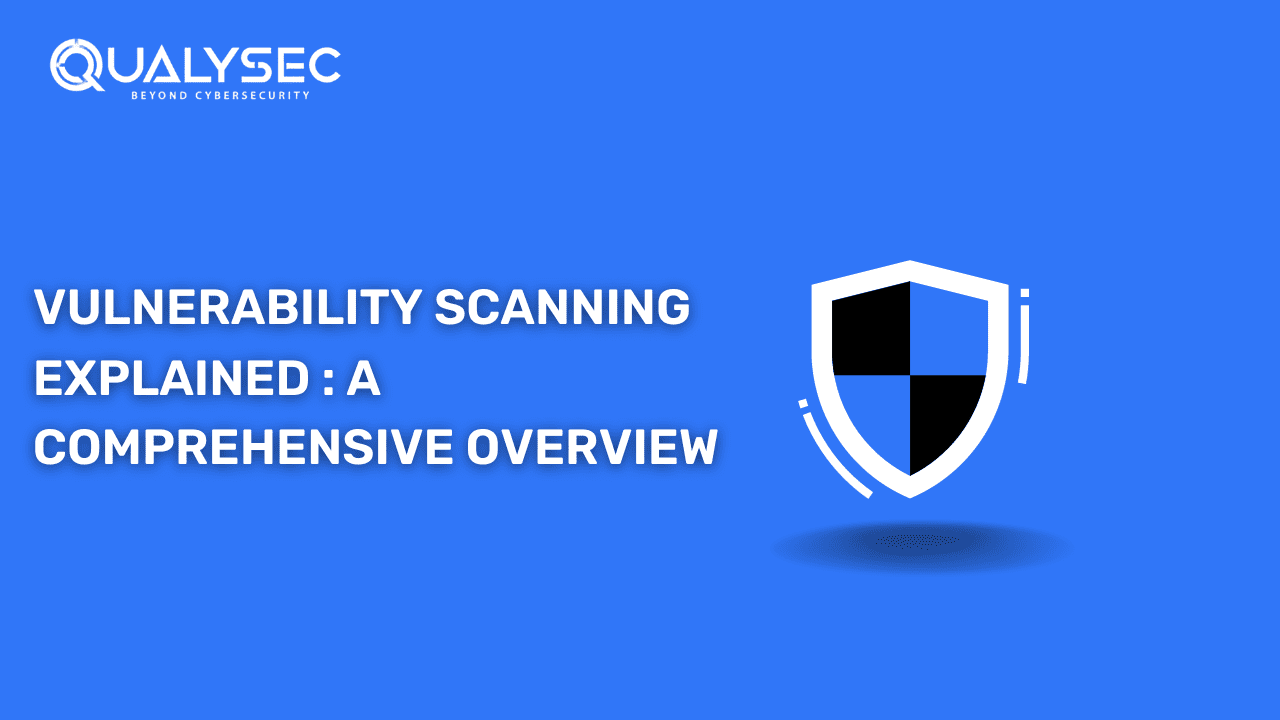© 2024 Qualysec.com Disclaimer Privacy Policy Terms & Conditions

In today’s interconnected and data-driven world, cybersecurity, including vulnerability scanning, has emerged as a cornerstone of safeguarding digital assets, privacy, and business continuity. With the ever-present threat of cyberattacks, understanding and implementing effective cybersecurity measures have become essential for individuals, businesses, and organizations of all sizes. This introduction sheds light on the paramount importance of cybersecurity, with a focus on vulnerability scanning, and offers a concise overview of two critical practices within the cybersecurity realm: penetration testing and vulnerability assessment.
The importance of cybersecurity, particularly vulnerability scanning, cannot be overstated. In an era where digital technologies are integral to our daily lives and business operations, the potential risks and vulnerabilities have multiplied exponentially. Cyberattacks, ranging from data breaches to ransomware and beyond, can result in dire consequences, both financially and reputationally. Moreover, the rise in remote work and the increasing interconnectivity of devices has expanded the attack surface, making vulnerability scanning and cybersecurity a pivotal aspect of modern life.
Effective cybersecurity safeguards, such as vulnerability scanning, not only sensitive personal information but also the critical infrastructure that underpins various industries. It preserves the trust of clients and partners, ensuring that their data remains secure. Furthermore, in the context of businesses, a robust cybersecurity strategy is indispensable for business continuity. As such, understanding and implementing cybersecurity best practices, including vulnerability scanning, are no longer optional but a necessary part of our digital existence.
Penetration testing and vulnerability assessment, including vulnerability scanning, are two essential practices within the realm of cybersecurity. Penetration testing, often referred to as pen testing, involves simulating cyberattacks to identify vulnerabilities and weaknesses in an organization’s digital infrastructure. It aims to evaluate the effectiveness of security measures and discover any potential entry points for malicious actors. On the other hand, vulnerability assessment, which includes vulnerability scanning, focuses on systematically identifying, classifying, and prioritizing vulnerabilities in a system. It provides a comprehensive view of potential weaknesses, which can then be addressed to enhance overall security.
Both practices, including vulnerability assessment, play critical roles in a holistic cybersecurity strategy. Penetration testing reveals how well an organization can withstand real-world attacks, while vulnerability assessment, including vulnerability scanning, identifies weaknesses before they can be exploited. Understanding the differences and nuances between these two approaches is fundamental to developing a robust cybersecurity posture and safeguarding digital assets effectively.
A penetration test, often referred to as a “pen test,” is a proactive and systematic approach to evaluating the security of a computer system, network, or application by simulating real-world cyberattacks. The primary objective of a penetration test is to identify vulnerabilities, weaknesses, and potential entry points that malicious actors could exploit. By replicating the actions of a skilled hacker, a penetration test seeks to uncover security gaps and assess the effectiveness of an organization’s cybersecurity measures.
The primary purpose of a penetration test is to provide organizations with a clear and actionable understanding of their cybersecurity posture. By simulating cyberattacks, it helps uncover vulnerabilities and weaknesses that may otherwise go undetected. Penetration testing also allows organizations to:
Penetration tests employ a variety of techniques and methodologies, including network scanning, social engineering, application testing, and vulnerability exploitation. Skilled penetration testers use a combination of manual and automated tools to simulate cyberattacks, aiming to compromise systems and access sensitive data. These techniques are executed within a controlled environment, ensuring minimal disruption to regular operations.
The benefits of conducting penetration tests are manifold. These tests provide:
Organizations should consider penetration tests in various scenarios, including:
Incorporating penetration testing into your cybersecurity strategy is a proactive and vital step to protect your digital assets and data, as well as to maintain the integrity of your organization’s security measures.
A vulnerability assessment, often incorporating vulnerability scanning, is a systematic process of identifying, evaluating, and prioritizing potential weaknesses and security flaws within an organization’s computer systems, networks, and software applications. The primary objective of a vulnerability assessment is to proactively detect and analyze vulnerabilities before they can be exploited by malicious actors. It involves using specialized tools and methodologies to scan, assess, and report on security weaknesses, allowing organizations to take appropriate actions to mitigate the identified risks.
The key purposes of a vulnerability assessment are to:
Vulnerability assessments commonly involve the use of:
The benefits of conducting vulnerability assessments, including vulnerability scanning, include:
Vulnerability assessments are valuable in various scenarios, including:
Vulnerability assessments, including vulnerability scanning, are a fundamental component of a comprehensive cybersecurity strategy, enabling organizations to proactively manage and mitigate security risks, maintain compliance, and bolster their overall security defenses.

Qualysec is a cybersecurity company founded in 2020 that has quickly become one of the most trusted names in the industry. The company provides services such as VAPT Testing, security consulting, and incident response.
Although Qualysec’s Oppressional office is not in Mexico, Qualysec’s extensive knowledge and expertise in cybersecurity testing services have earned a reputation among the Top Vulnerability Service Providers.
Technicians at Qualysec can detect flaws that fraudsters could abuse. After these flaws have been found, Qualysec collaborates with the organization to establish a plan to address them and boost the company’s overall security posture. Among the several services available are:
The Qualysec team, comprising seasoned offensive specialists and security researchers, collaborates to provide their clients with access to the latest security procedures and approaches. They provide VAPT services using both human and automated equipment.
In-house tools, adherence to industry standards, clear and simple findings with reproduction and mitigation procedures, and post-assessment consulting are all features of Qualysec’s offerings.
The solution offered by Qualysec is particularly beneficial for businesses that must adhere to industry rules or prove their dedication to security to clients and partners. So, by doing routine penetration testing, businesses may see weaknesses and fix them before thieves attack them.
Qulaysec’s comprehensive range of cybersecurity solutions encompasses. These include threat detection, risk assessment, and incident response, making it a go-to choice for organizations. Organizations looking to safeguard their digital assets. With a focus on innovation and a dedicated team of experts, Qulaysec continues to be a cornerstone in the vulnerability assessment landscape.
While both penetration tests and vulnerability assessments play pivotal roles in enhancing cybersecurity, they differ significantly in their goals, methods, and applications.
The primary distinction lies in their core objectives. Penetration tests are designed to simulate real-world cyberattacks and actively exploit vulnerabilities to assess an organization’s ability to withstand an attack. In contrast, vulnerability assessments are focused on identifying and categorizing vulnerabilities, often without actively attempting to exploit them. Penetration tests aim to test an organization’s defenses, while vulnerability assessments aim to identify weaknesses for subsequent remediation.
Penetration tests employ techniques like network scanning, password cracking, and social engineering to actively exploit vulnerabilities. In contrast, vulnerability assessments rely on techniques like network scanning and vulnerability scanning to passively identify vulnerabilities. Vulnerability scanning plays a central role in vulnerability assessments by using automated tools to detect known vulnerabilities and misconfiguration.
The benefits of penetration tests include the ability to assess an organization’s ability to withstand real-world attacks, the identification of critical vulnerabilities, and heightened security awareness. In contrast, the benefits of vulnerability assessments include proactive risk management, compliance fulfillment, cost savings, and an enhanced understanding of an organization’s security posture. Vulnerability scanning is a core component in both processes, facilitating the identification of vulnerabilities.
Penetration tests are best employed when an organization wants to test its defenses under realistic conditions, assess the effectiveness of incident response, and identify critical vulnerabilities that could be exploited by malicious actors. Vulnerability assessments are most valuable when an organization aims to proactively manage risks, meet compliance requirements, save costs associated with breaches, and gain a comprehensive understanding of its security posture. Vulnerability scanning is a consistent practice in both scenarios to identify and address vulnerabilities effectively.
In summary, while both penetration tests and vulnerability assessments leverage vulnerability scanning as a key component of their processes, their fundamental differences in objectives and methodologies make them suited for distinct roles in a comprehensive cybersecurity strategy. Organizations can choose the approach that aligns with their specific security goals and requirements.
In the realm of cybersecurity, the distinction between penetration testing and vulnerability assessment is clear, as each serves a unique purpose with distinct methodologies. Penetration testing involves ethical hacking attempts to actively exploit vulnerabilities, providing valuable insights into an organization’s preparedness against real-world cyberattacks. On the other hand, vulnerability assessments focus on the systematic identification and prioritization of vulnerabilities, without exploiting them, ultimately guiding organizations in mitigating weaknesses proactively.
The importance of choosing the right cybersecurity method cannot be overstated. Your choice between penetration testing and vulnerability scanning depends on your specific needs, goals, and the context in which you operate. Both methods play pivotal roles in strengthening cybersecurity measures and maintaining a robust defense against cyber threats. While penetration testing is instrumental in assessing real-world resilience and response capabilities, vulnerability assessments enable organizations to take a proactive approach to identify and prioritize vulnerabilities for remediation.
In conclusion, a well-rounded cybersecurity strategy should encompass both penetration testing and vulnerability scanning, as they complement each other to create a comprehensive security posture. The key lies in understanding when and how to leverage each method effectively, and integrating them into a holistic security approach that safeguards digital assets and maintains the trust of clients and partners. In an ever-evolving cybersecurity landscape, staying vigilant and adaptable is paramount, and both penetration testing and vulnerability assessments play critical roles in this ongoing journey.
Answer: The main difference lies in their approach. Penetration testing actively simulates real-world cyberattacks to exploit vulnerabilities, while vulnerability assessment focuses on systematically identifying and documenting vulnerabilities without attempting to exploit them.
Answer: The choice depends on your specific cybersecurity goals. Penetration testing is suitable for simulating attacks and measuring an organization’s preparedness, while vulnerability assessment is ideal for proactive management of vulnerabilities and compliance with industry regulations.
Answer: Vulnerability scanning is one of the techniques used in a vulnerability assessment. Vulnerability scanning involves automated tools to detect known vulnerabilities, while a vulnerability assessment encompasses a broader process of identifying, classifying, and prioritizing vulnerabilities.
Answer: It varies based on your organization’s needs and industry regulations. Routine security audits, including both practices, are recommended. However, you might need more frequent assessments, especially after security incidents or significant system changes.
Answer: Yes, they can complement each other. Vulnerability scanning can identify weaknesses, and penetration testing can reveal how well your organization can withstand real-world attacks. Combining both practices enhances your overall security posture.
These FAQs and answers should provide valuable insights for readers interested in understanding the differences and benefits of penetration testing and vulnerability assessment.